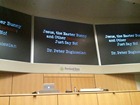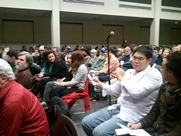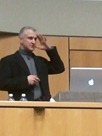 Dr. Peter Boghossian, philosophy professor at Portland State University in Oregon, gave a provocative talk last night (January 27, 2012) at Hoffman Hall at PSU titled, “Jesus, the Easter Bunny, and Other Delusions: Just Say No!” Philosophy News was there and the event lived up to the hype (see the link to our tweetcast of the event below). Professor Boghossian doesn’t mince words when it comes to his opinion about faith. Not only are faith claims false, he argues, they have all the earmarks of being delusional. And while many people believe their faith either is harmless or even helpful, Boghossian claims that any beliefs that are based on a delusion are in fact detrimental to the person holding them. Faith claims should be rejected on this ground.
Dr. Peter Boghossian, philosophy professor at Portland State University in Oregon, gave a provocative talk last night (January 27, 2012) at Hoffman Hall at PSU titled, “Jesus, the Easter Bunny, and Other Delusions: Just Say No!” Philosophy News was there and the event lived up to the hype (see the link to our tweetcast of the event below). Professor Boghossian doesn’t mince words when it comes to his opinion about faith. Not only are faith claims false, he argues, they have all the earmarks of being delusional. And while many people believe their faith either is harmless or even helpful, Boghossian claims that any beliefs that are based on a delusion are in fact detrimental to the person holding them. Faith claims should be rejected on this ground.
The event was very well attended. People were lining up 30 minutes before the talk in freezing temperatures in order to secure a seat and before Peter got up to  talk, the large hall was packed to standing room only. There was a tremendous amount of interest in the topic and the audience was fully engaged (a couple even enraged) throughout the evening (most even staying through a 10 minute break for the opportunity to ask a question). The event was managed well and professionally done. Peter’s slides were slick sporting single words or nicely-produced images that were both evocative and controversial. The speaker nailed the talk.
talk, the large hall was packed to standing room only. There was a tremendous amount of interest in the topic and the audience was fully engaged (a couple even enraged) throughout the evening (most even staying through a 10 minute break for the opportunity to ask a question). The event was managed well and professionally done. Peter’s slides were slick sporting single words or nicely-produced images that were both evocative and controversial. The speaker nailed the talk.
His core thesis was rather simple and, on the face of it, relatively uncontroversial: there are some belief-producing processes that get one closer to reality (they’re reliable) and others that move one further away. He gave an example: he has a door in his home that has a hole in it and needs repair. Given that he’s unskilled in home repair, how should he go about figuring out how best to fix the door, he asked. He gave some options that he assumes most people would think are bad ways. He could ask his dog, he could use divination, he could sacrifice a goat and hope he gets some inspiration. He admits that, using these methods, he might stumble upon the “right way” but if he did so, it would be by pure luck. These are not reliable processes. These processes generally lead to unreliable conclusions. This, he hoped, would be a relatively uncontroversial claim. Most in the audience seemed to agree.
 He then asked, “What are our epistemic goals?” Aligning with traditional epistemology, he provided the answer: maximize true beliefs and minimize false ones. The best way to maximize true beliefs is to use reliable belief-producing processes to form beliefs. Those processes are ones that use evidence to support one’s conclusions.
He then asked, “What are our epistemic goals?” Aligning with traditional epistemology, he provided the answer: maximize true beliefs and minimize false ones. The best way to maximize true beliefs is to use reliable belief-producing processes to form beliefs. Those processes are ones that use evidence to support one’s conclusions.
Faith, he then claimed, is not a reliable belief-producing process because it’s not based on evidence. It was here that he dropped his bombshell. Not only are conclusions based on faith false, but they’re delusional. He supported this claim by providing three tests of delusional beliefs. The people that hold them believe they are certain. They are incorrigible (not subject to falsification) for that person. And the beliefs themselves are implausible. He gave the example of believing that the Eucharist transforms into the body and blood of Christ. People that believe this appear to be certain its true. Further, if scientific tests were done to show that the wafer remains a wafer (it has the properties of bread not of human flesh) this will not be enough to disabuse the believer of her belief—nor would any other evidence. Thus the belief is incorrigible for that person. Finally, the idea that a bit of bread would turn into the body of a human-divine being (an idea which also doesn’t have the ring of truth to it) and then that we should eat this thing, itself is implausible.
All faith claims have these properties and so all faith claims are delusional and do not get one closer to reality. Just say no, Boghossian urged.
The most amusing part of the evening happened towards the end of the talk. Professor Boghossian gave an altar call asking people to come forward and jettison their faith. He talked about how, with a simple decision, they could cease to be shackled by their faith and live a new, free life. It drew laughs and scattered applause from the audience.
 Not everyone in the audience were friendlies. One gentleman, clearly angry at what he viewed as the speakers bias and disinclination to engage with those who disagree, passed out a typed manifesto before the talk hoping to enlighten the audience to the Boghossian’s apparent hypocrisy. This came out even more strongly in the Q/A session where, stepping to the microphone, he challenged Peter and angrily demanded that he debate him and allow him to come to his classes. Ignoring the moderator, he became more and more shrill until a student of Boghossian jumped up and said to the man, “I’m in his class and I don’t want you there!”
Not everyone in the audience were friendlies. One gentleman, clearly angry at what he viewed as the speakers bias and disinclination to engage with those who disagree, passed out a typed manifesto before the talk hoping to enlighten the audience to the Boghossian’s apparent hypocrisy. This came out even more strongly in the Q/A session where, stepping to the microphone, he challenged Peter and angrily demanded that he debate him and allow him to come to his classes. Ignoring the moderator, he became more and more shrill until a student of Boghossian jumped up and said to the man, “I’m in his class and I don’t want you there!”
Peter’s certainly is not the last word on this subject and his talk was intended to generate interest and discussion—and it certainly did (I overheard attendees talking about it blocks away as I walked to get dinner at local pub). When all was said and done, Peter left the stage to a standing ovation having clearly connected with his audience and used his material in a maximally effective way. In graduate school, I took a class titled, “Philosophical Debate” in which the professor explained that every public debate needs to connect on three levels: logos – you must know your material; pathos – you must connect with your audience; and ethos – you must connect with and respect your interlocutor. Agree with him or not, Professor Boghossian accomplished all three with aplomb.
While there, I tweetcasted the entire event. You can read that tweetcast here (browse to January 27, 2012 for the feed).
To hear more about Dr. Boghossian’s views on this topic, check out our podcast recorded in December of 2011.
**Update (2/14/2012): The video of Peter’s presentation is now available here.








